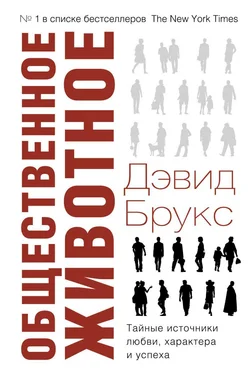Murray R. Barrick, Michael К. Mount, and Timothy A. Judge, «Personality and Performance at the Beginning of the New Millennium: What Do We Know and Where Do We Go Next?», International Journal of Selection and Assessment 9, no. 1-2 (March/June 2001): 9-30.
Ulrike Malmendier and Geoffrey Tate, «Superstar CEOs,» Quarterly Journal of Economics, 124, no. 4 (November 2009): 1593-1638.
Tyler Cowen, «In Which Countries Do Kids Respect Their Parents Die Most?», Marginal Revolution, December 5, 2007.
Judith Rich Harris, The Nurture Assumption: Why Children Turn Out the Way They Do (New York: Touchstone, 1998), 56.
David Brooks, «The Americano Dream,» New York Times, February 24, 2004.
Richard Nisbett, The Geography of Thought: How Asians and Westerners Think Differently… and Why (New York: Free Press, 2003), 90.
Nisbett, 100.
Alison Gopnik, Andrew N. Meltzoff, and Patricia Kuhl, The Scientist in the Crib: What Early Learning Tells Us About the Mind (New York: Perennial, 2001), 89.
Nisbett, 95.
Nisbett, 140.
Nisbett, 87-88.
Timothy D. Wilson, Strangers to Ourselves: Discovering the Adaptive Unconscious (Cambridge, MA: Belknap Press, 2002), 38.
Bruce E. Wexler, Brain and Culture: Neurobiology, Ideology, and Social Change (Cambridge, MA: MIT Press, 2006), 149.
John Roach, «Chinese, Americans, Truly See Differently, Study Says,» National Geographic News, August 22, 2005.
Rachel E. Jack et al., «Cultural Confusions Show that Facial Expressions Are Not Universal,» Current Biology 19, no. 18 (August 13, 2009), 1543-48.
Wexler, 175.
Roy F. Baumeister, The Cultural Animal: Human Nature, Meaning and Social Life (Oxford: Oxford University Press, 2005), 31.
Baumeister, 131.
Clifford Geertz, The Interpretation of Cultures (New York: Basic Books, 1973), 46.
Andy Clark, Being There: Putting Brain, Body, and World Together Again (Cambridge, MA: MIT Press, 1998), 191.
Baumeister, 53.
Wexler, 33.
Donald E. Brown, Human Universals (New York: McGraw-Hill, 1991).
Wexler, 187-88.
David P. Schmitt, «Evolutionary and Cross-Cultural Perspectives on Love: The Influence of Gender. Personality, and Local Ecology on Emotional Investment in Romantic Relationships,» in The New Psychology of Love, eds. Robert J. Sternberg and Karin Sternberg (New Haven, CT: Yale University Press, 2006), 252.
Helen Fisher, Why We Love: The Nature and Chemistry of Romantic Love (New York: Henry Holt & Co., 2004), 5.
Craig MacAndrew and Robert В. Edgerton, Drunken Comportment: A Social Explanation (Clinton Comers, NY: Percheron Press, 2003).
Dacher Keltner, Born to Be Good: The Science of a Meaningful Life (New York: W. W Norton & Co., Inc., 2009), 195.
Steven Pinker, The Blank Slate: The Modem Denial of Human Nature (New York: Penguin Books, 2002), 328.
Marc D. Hauser, Moral Minds: The Nature of Right and Wrong (New York: Harper Perennial, 2006), 134.
Guy Deutscher, «You Are What You Speak,» The New York Times Magazine, August 26, 2010, 44.
Douglas Hofstadter, I Am a Strange Loop (New York: Basic Books, 2007), 177.
David Halpern, The Hidden Wealth of Nations (Cambridge: Polity Press, 2010), 76.
Thomas Sowell, Migrations and Cultures: A World View (New York: Basic Books, 1996), 378.
Lawrence E. Harrison, The Central Liberal Truth: How Politics Can Change a Culture and Save It from Itself (Cambridge: Oxford University Press, 2006), 26.
Thomas Sowell, Race and Culture: A World View (New York: Basic Books, 1994), 67.
Sowell, Race and Culture, 25.
Margaret Bridges, Bruce Fuller, Russell Rumberger, and Loan Tran, «Preschool for California’s Children: Unequal Access, Promising Benefits,» PACE Child Development Projects, University of California Linguistic Minority Research Institute (September 2004): 7.
Abigail Thernstrom and Stephan Thernstrom, No Excuses: Closing the Racial Gap in Learning (New York: Simon & Schuster, 2003), 85.
David Brooks, «The Limits of Policy», New York Times, May 3, 2010.
Fisman, Raymond, and Edward Miguel, «Corruption, Norms and Legal Enforcement: Evidence from Diplomatic Parking Tickets,» Journal of Political Economy 115, no. 6 (2007): 1020-48.
Harrison, 53.
Francis Fukuyama, Trust: The Social Virtues and the Creation of Prosperity (New York: Free Press, 1996), 338.
Edward Banfield, The Moral Basis of a Backward Society (New York: Free Press, 1967).
Richard Ogle, Smart World: Breakthrough Creativity and the New Science of Ideas (Boston, MA: Harvard Business School Press, 2007), 8-10.
Ronald Bun, Structural Holes: The Social Structure of Competition (Cambridge, MA: Harvard University Press, 1992).
Matt Ridley, The Agile Gene: How Nature Turns on Nurture (New York: Perennial, 2004), 59.
Daniel Goleman, Social Intelligence: The New Science of Human Relationships (New York: Bantam Dell, 2006), 139.
John Medina, Brain Rules: 12 Principles for Surviving and Thriving at Work, Home, and School (Seattle, WA: Pear Press, 2008), 262.
Michael S. Gazzaniga, Human: The Science Behind What Makes Us Human (New York: Harper Perennial, 2008), 96.
Peter A. Hall and David W. Soskice, «An Introduction to the Varieties of Capitalism,» in Varieties of Capitalism: The Institutional Foundations of Comparative Advantage, eds. Peter A. Hall and David W. Soskice (Oxford: Oxford University Press, 2004), 1-70.
Arthur Robert Jensen, The G Factor: The Science of Mental Ability (Westport, CT: Praeger Publishers, 1998), 34-35.
Robin Karr-Morse and Meredith S. Wiley, Ghosts from the Nursery: Tracing the Roots of Violence (New York: Atlantic Monthly Press, 1997), 28.
Читать дальше












